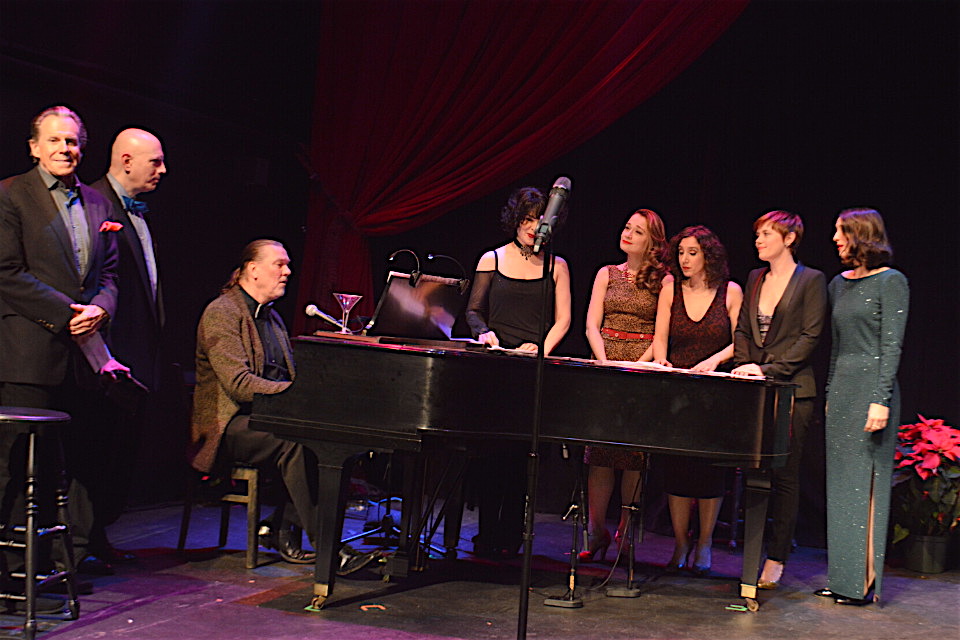By Marilyn Lester
Calling it ‘the best Broadway musical that never was,’ host and producer Will Friedwald presented the extraordinary story of Manhattan Tower at Winter Rhythms-Urban Stages. It’s the tale of an important, groundbreaking album, now pretty much forgotten. But Manhattan Tower was a huge hit when it debuted in 1946, and remained so for more than a decade. The piece was composed by conductor Gordon Jenkins as an original work for orchestra, narrator, and solo singers. It was the very first “concept album,” predating classics such as the Beatles’ Sgt. Pepper’s Lonely Hearts Club Band and the Who’s Tommy.
The first clip of the evening was the presentation of the entire original work on Ed Sullivan’s Toast of the Town TV show in early 1950, bringing to life Jenkins’ ode to his beloved New York City. The work tells the story of “Stephen” (sung by Elliott Lewis) who travels to New York City for a visit, finds an apartment in the tower he’s oft dreamt about, and falls in love with the girl, “Julie” (sung by Beverly Mahr). The original work is short – just four tracks, since the long-playing album hadn’t yet been invented.
In the “Stage Show” segment of the evening, with Bill Boggs and Friedwald providing narration, the first number,”Magical City,” was sung by the entire cast and the second “Once Upon a Dream” was offered by Margi Gianquinto in a mellow voice reminiscent of 1940s band singers. “New York’s My Home” was delivered by Gabrielle Stravelli in her sure, jazzy style, while finishing up the original work was Sigali, in clear operatic voice with “Love in a Tower.”
Because of the invention of the LP, first as a 10-inch disc, and then as a 12-inch product, Jenkins expanded Manhattan Tower in 1956 to 14 songs, including the originals. This version was shown on television that year by the NBC network as a Saturday Spectacular, starring Peter Marshall as Stephen and Helen O’Connell as Julie. This show was feared lost, but the second half, shown by Friedwald, was recently discovered in the Library of Congress. From the expanded Manhattan Tower, “Happiness Cocktail” was sung live by Gianquinto and “I’m Learnin’ My Latin” and “Married I Can Always Get” by the powerfully interpretive Lianne Marie Dobbs.
For further context about the composer Jenkins, Jeff Harnar appeared to share a personal Manhattan Tower story, which included finding a 10-inch version at a rummage sale (in his teen years) – featuring Anne Margaret, with whom he had a “six degrees of separation” connection. Jenkins also wrote a 1953 sequel to Manhattan Tower, entitled Seven Dreams. From this album, the number “Crescent City Blues” was sung by Carole J. Bufford in her now trademark “hot mamma” style. For the short-lived Broadway revue Along Fifth Avenue, Jenkins wrote “Skyscraper Blues,” sung by Stravelli, with a clip of Dick Haymes singing the song on the Ernie Kovacs Show also shown. Bill Boggs, who as a young man had always wanted to sing one of Jenkins most famous songs, “This Is All I Ask” (written in 1958) had his (now age-appropriate) wish come true. Last but not least, a final clip, a production number of “Married I Can Always Get” on the Perry Como Show, featured a singing/dancing Anne Bancroft, and a remarkably trained cat.
Friedwald, who admits to an obsession with Manhattan Tower, referred to it as forward-thinking in structure, but corny in content. The dramatic narrative has often been referred to as such. Yet, it didn’t come off this way so much, owing to that polymath of a Musical Director, Jon Weber. Weber’s tailored arrangements of the songs and music of Manhattan Tower elevated the work into the 21st century. Hats off to Friedwald and all the participants of Manhattan Tower for showcasing an important part of musical history that deserves an ongoing life.
Winter Rhythms: Will Friedwald’s CLIP JOINT presents GORDON JENKINS’S “MANHATTAN TOWER”: a 70th Anniversary celebration,
Urban Stages, 259 W. 30th St., 212-695-5131, www.urbanstages.org
Photos: Maryann Lopinto





















